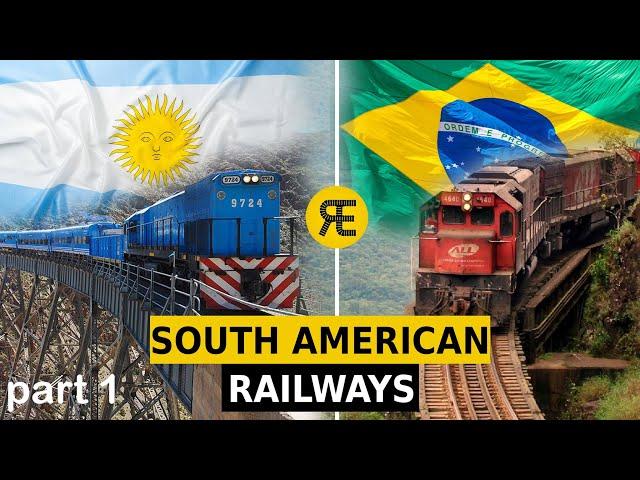
South America’s Railway Struggle: Brazil and Argentina Explained │ Part 1
Комментарии:

Hi ! Please make a video for Sri Lankan Railways.❤❤ from Sri Lanka.
Ответить
Some facts:
- Vila do Conde is located in Northern Brazil, near Belém. This location in the video is Santos Port
- São Paulo is one of very few metropolis without long-distance passenger train services. But a new 104 km-long intercity passenger railway line from São Paulo to Campinas is under construction - trains will run at 120 km/h. A consortium between CRRC and a intercity bus companies holding (like British National Express) will operate it

Are any works planned on Belgrad-Zagreb railway? Any chance for direct train Belgrad-Zagreb?
Ответить
Even if the freight network is clearly more extensive, the passenger and urban services of the railway network in Brasil and Argentina are more relevant to the society and usually under public pressure to expand and improve the services. I would have loved to see a more in depth Railway Explain on urban service from Brasil and Argentina.
Ответить
there is no connections between countries, is garbage, is colonial mindset
south americans are white wanabe eurocentric, all they dream is to be european
all is based in move natural resources out, not at all to do internal trade, the reason is that elites do not want ot live in southamerica, they dream about living in europe
south america still is a colony,

Poor documentation in the case of Argentina. A table is shown indicating only the 1,676 mm gauge compared to other gauges in Chile and Bolivia, but in reality there were four international connections using 1 meter gauge (two with Chile and two with Bolivia), although today only one of them operates with Chile. A map is also shown with an unrealistic network in 2014, because it only shows the corridors with passenger services, while the adjacent map shows the entire network in the 1970s and 1980s, but many sections no longer operated passenger services. I recommend consulting reliable sources of information and not just internet searches; there are important non-state institutions that seriously study the past, present, and future of the railways; this will allow them to present a more realistic picture of the current (delicate) state of Argentina's railways.
Ответить
Oh, research on feasibility is better than repeating the system that we already know well about
Ответить
I just started to map a rail trip to South America. Perfect timing
Ответить
I keep wondering what it takes for south americans to realise that a uniform gauge would be the best thing for them, and of course in 1.44 m (standard gauge). If the europeans don't manage to school them about such a regauging project, maybe the chinese could? - NB: The letter I in Mitre (Buenos Aires province) is not pronounced as in english, but 'normally'
Ответить
Talk about chileeee
Ответить
As a Brazilian that loves trains, I can attest that one of the biggest challenges for the expansion of rail transport in Brazil is that most of our 1,000 mm railways have very outdated geometry compatible with speeds no higher than 40-60 km/h, which hinders profitability immensely. Our 1,600 mm network is much more modern and efficient, but only represents 16% (less than 5,000 km) of railways. The expansion of the broad gauge network is paramount if Brazil intends to shift away from its crippling dependence on long-distance road transport.
We even have a term for that; it’s the “Brazil tax”. The added cost from inefficient transport that decreases the competitiveness of our exports worldwide. The North-South Railway was constructed in an attempt to address this major issue.

What about a high-speed rail route connecting Santiago to Buenos Aires?
Ответить
Argentina's declining railways is largely down to hyperinflation which has stifled the ability to improve Argentina's railway network.
As for the Kirchnerist's railway nationalisation, and the subsequent Chinese investment, I would not be overly convinced that such investment will last long-term, although that may change if Javier Milei re-privatises the Argentinian railway network - This is an outsiders' perspective.

uraguay thogh small and poor is reviving its rail system.
Ответить
Rail in the Americas is sad in general
Ответить
Rail in the Americas is sad in general
Ответить
ARGENTINA TIENE 4 ANCHOS DE VIA Y EL DOCUMENTAL ES MUY MALO DISLIKE
Ответить
these videos play like they were researched by AI
Ответить
Really interesting to learn about trains in other continents!
Ответить
Argentine here. The complexities and struggles of our rail system (as well as its history and fragile future) are huge and I feel like this video doesn't exactly do the best job at tackling them. For a local, it feels like this was barely researched, lacks nuances, or is explained very broadly and without proper care for our everyday reality. I understand that this isn't done out of malice, as this is a foreign channel and you have no reason to hold knowledge of the topics at hand, but if you're going to make a video on the matter for a global audience PLEASE inform yourselves better. We have a thriving community of people who love rail transport online, with plenty of looked-upon engineers and historians who would do an amazing job reporting the intricacies of our (deranged) train system.
Ответить
Having the terrible experience of privatizing the largest railway network in South America, Argentina, now the abominable Milei wants to re-privatize it again. Belgrano Cargas is constantly growing and is a profitable company.
The only thing privatizations brought was the dismantling and abandonment of the excellent and well-maintained network of the 1990s. Only a fool would try to do something that doesn't work again for the third time. This not only led to the abandonment of hundreds of towns across the country, but also led to a squandering of nearly two centuries of development. Shameful. Now it turns out that it was Kirchner who "stole everything." They have no shame.

that pronounciation was SPOT ON
holy cow
nvm, Carahas?

I´d like to see maps of the whole networks of Brazil and Argentina, and where the different gauge lines are etc.
Ответить
Great video as usual :]
Ответить
Even though I'm Brazilian, I love seeing locomotives from the 50s, the GE U10b and ALCO RSD8, working even on old lines, it gives a very underground atmosphere.
Ответить

























